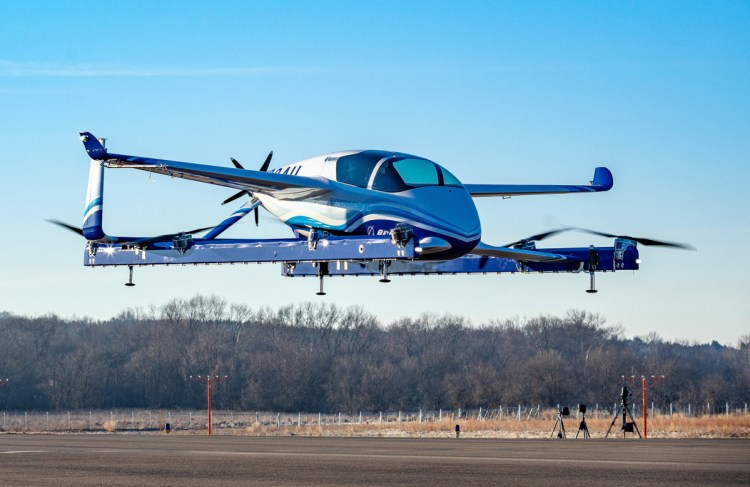Boeing offered a glimpse at a futuristic alternative to crowded freeways when its prototype autonomous air taxi – essentially a flying car with no driver – lifted off the ground for the first time on a test takeoff.
“In one year, we have progressed from a conceptual design to a flying prototype,” said Boeing Chief Technology Officer Greg Hyslop, adding that Boeing will leverage its decades of aviation expertise to create an air mobility technology that’s “safe, innovative and responsible.”
Boeing subsidiary Aurora Flight Sciences, a leading developer of innovative aircraft and autonomous systems that Boeing acquired in 2017, designed the electric vertical takeoff and landing aircraft. Its first flight took place Tuesday at Aurora’s headquarters in Manassas, Virginia.
With a range of up to 50 miles, the air taxi is 30 feet long and 28 feet wide. Its advanced airframe uses movable propellers and wings to achieve efficient hover and forward flight.
“This is what revolution looks like,” said John Langford, Aurora’s president and CEO. He said the key to the technology will be autonomy – the aircraft is intended to fly itself, using sensors and artificial-intelligence software to avoid obstacles and other flying vehicles as it delivers passengers.
Langford said Boeing’s technology will “make quiet, clean and safe urban air mobility possible.”
Other companies are also rushing to develop similar air taxis to open up the urban skies, supplementing the current clogged ribbons of highway with flight paths crisscrossing the three-dimensional space above our heads.
A year ago in Pendleton, Oregon, European jet maker Airbus completed a similar test takeoff of its Vahana autonomous air-taxi prototype at a drone test range, the aircraft rising 16 feet into the air and then descending safely.
The next step in these flight tests will be much more of an engineering challenge: transitioning from the vertical takeoff and hover phase to forward, wing-borne flight.
Many other startups are exploring the same urban air mobility concept. And Uber, in a partnership with Aurora Flight Sciences that predates Boeing’s acquisition of the company, is developing an urban aviation ride-sharing product called Uber Air, which it claims will be available by 2023 in Dallas and then in Los Angeles.
But Uber’s vehicle hasn’t flown yet. And don’t expect to see air taxis in the skies above Seattle for years. While the basic technology is advancing, the regulatory and safety barriers to deploying it are considerable.
Uber ride-share cars stopping in the middle of the narrow streets of South Lake Union to drop off or pick up Amazonians are already a road hazard at peak commute times. Imagine dozens of air taxis converging on the area as executives try to beat the bridge and tunnel traffic.
And realize that in this imagined future, these air taxis will share the air not only with the Kenmore Air seaplanes landing on the lake but with thousands of Amazon package-delivery drones flying low across the skies.
Boeing is separately developing an unmanned, fully electric cargo air vehicle designed to transport up to 500 pounds. It completed an indoor flight last year and will transition to outdoor flight testing this year.
Even a potential killer app for urban air taxis – whisking passengers arriving at Sea-Tac International Airport to the heart of downtown Seattle – in reality looms as more of an air traffic safety nightmare when you think about pilotless air vehicles and fully loaded passenger planes flying anywhere near each other.
Copy the Story LinkSend questions/comments to the editors.



Success. Please wait for the page to reload. If the page does not reload within 5 seconds, please refresh the page.
Enter your email and password to access comments.
Hi, to comment on stories you must . This profile is in addition to your subscription and website login.
Already have a commenting profile? .
Invalid username/password.
Please check your email to confirm and complete your registration.
Only subscribers are eligible to post comments. Please subscribe or login first for digital access. Here’s why.
Use the form below to reset your password. When you've submitted your account email, we will send an email with a reset code.